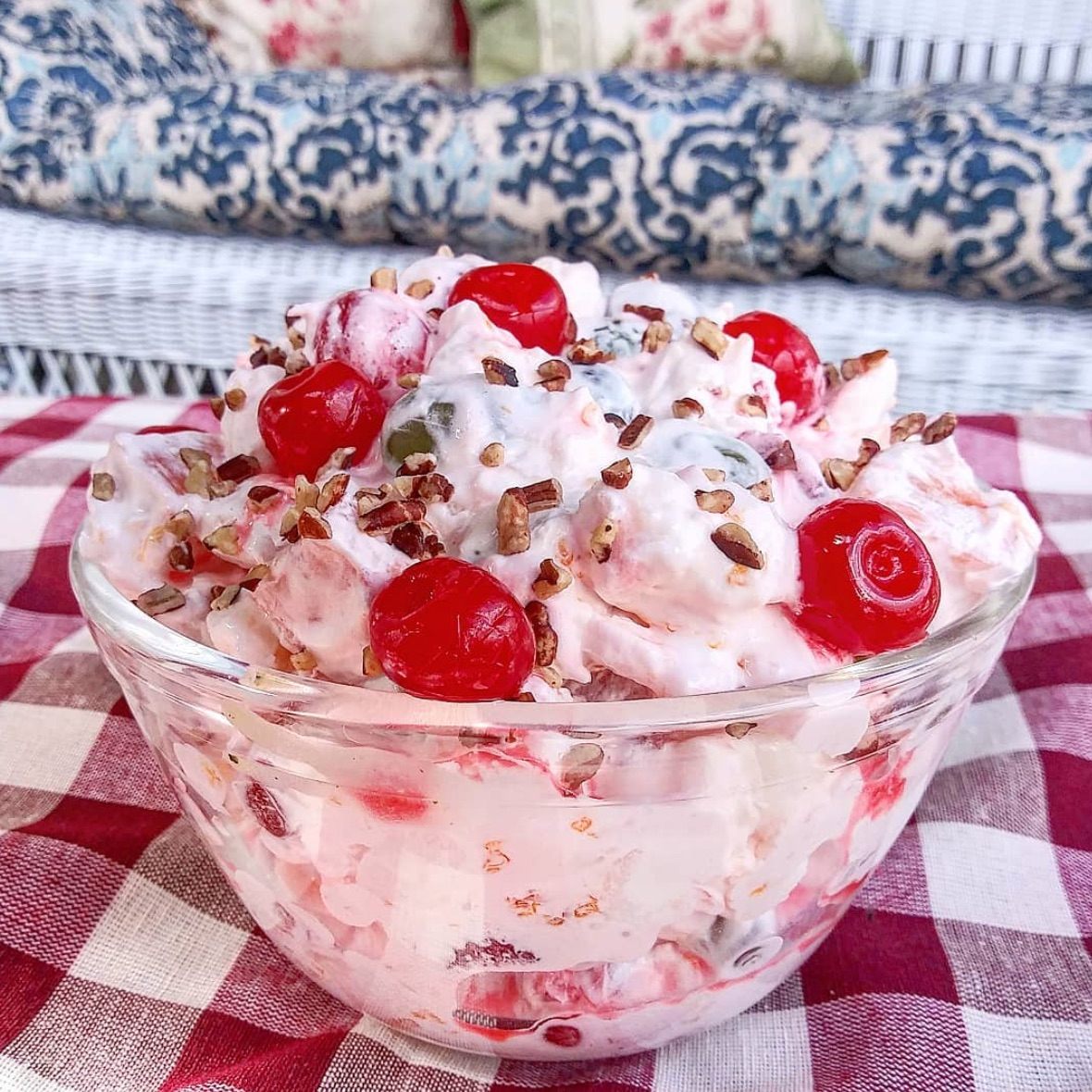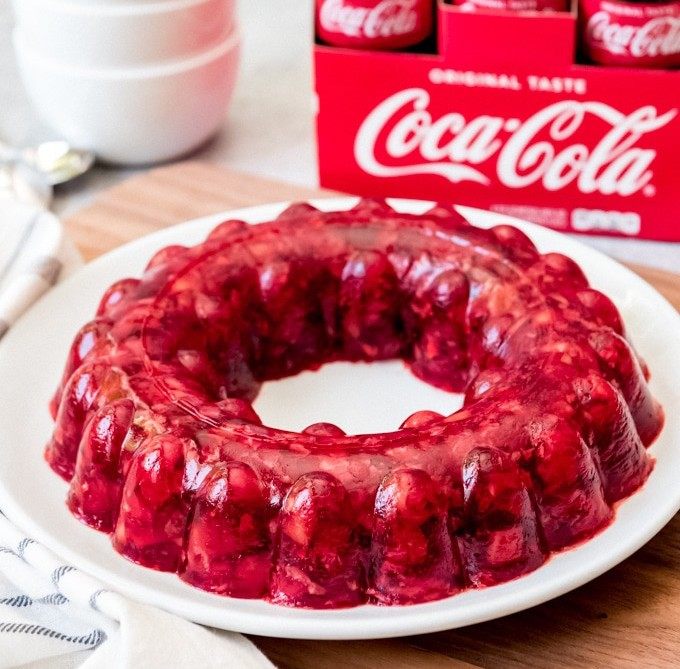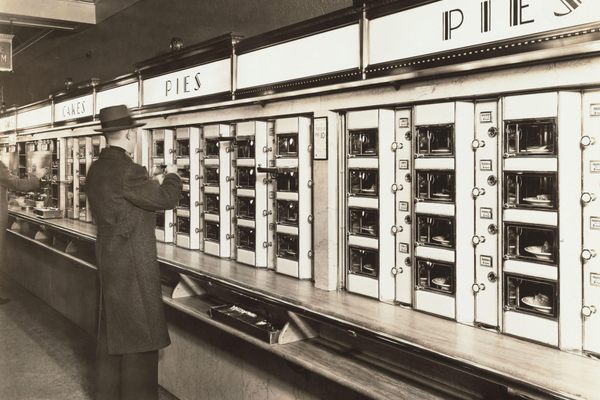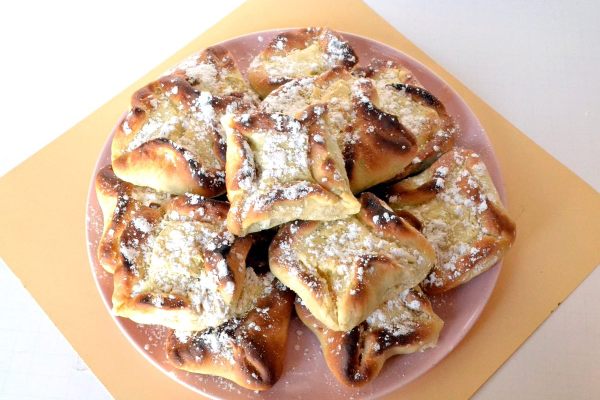Celebrate the Heyday of Sweet American ‘Salads’ With These 7 Dishes
Highlights from an era of convenience, creativity, and Cool Whip.
In the 1950s, a food trend swept the United States: the sweet salad. World War II had ended, and with it wartime rationing, but Americans’ penchant for canned goods persisted. The combination of the increased popularity of preserved foods and the overall postwar atmosphere of abundance led to a widespread love for dishes that were modern, decorative, and convenient. This included technicolor “salads” made from multiple processed ingredients, like powdered gelatin and canned fruit. Epitomizing this mix of social forces, in all its trembling, fruit-filled, jewel-hued glory, was the Jell-O mold. Consisting of a mix of sweet, and often savory, ingredients suspended in elaborate rings of wiggly instant gelatin, these creations shone from the pages of Betty Crocker and The Joy of Cooking books, and festooned the countertops of suburban America.
But love for gelatinous, creamy medleys did not originate in the 1950s. Americans had been enjoying sweet mixtures of grains and dairy, like rice pudding, for centuries. Many early recipes were delicacies, involving expensive nuts and exotic, hard-to-find fruits like pineapple, or labor-intensive processes like making gelatin at home. But the rise of industrial food production in the 1900s, including the popularizing of canning and instant foods like Jell-O, mainstreamed and democratized these unique dishes. They gained further popularity thanks to midcentury brands advocating “modern” convenience cooking, like Betty Crocker.
Since they’re affordable and don’t spoil easily, these sweet salads have long been heavy-hitters at family gatherings, funerals, and church potlucks. From ambrosia to Coca-Cola, from cookie to frog eye, they remain beloved fixtures of community life across the American South, Midwest, and Mountain West. Functioning as either a dessert or a sugary side dish, they’re an airy spoonful of nostalgia for many diners. While everything else may be uncertain, these seven salads affordably and reliably give comfort. After all, canned pineapple and whipped topping will always remain (shelf) stable and sweet.

Ambrosia Salad
In the pantheon of sweet salads, ambrosia takes first place. The name “ambrosia” comes from the mythical food of the Greek gods. The first known written reference to modern ambrosia salad, on the other hand, dates to 1867, when Maria Massey Barringer of North Carolina included a recipe for it in her Dixie Cookery cookbook. That recipe consisted of nothing more than grated, sweetened coconut layered with pulpy oranges.
In the 1870s and ’80s, ambrosia recipes began appearing in syndicated cooking columns. They emphasized the novelty of fresh coconut and citrus, in an age when train travel had just made long-distance trade in perishables possible. By the early 1900s, the dish had become associated with Southern Christmas celebrations. As the 20th century marched on, tropical fruits grew more common. The popularization of mini marshmallows added another key ingredient to the mix, as did the rise of canned goods during World War II.
Today, there are about as many ambrosia recipes as there are Southern grandmas. But at their base, recipes still include the core ingredients of canned pineapple or mandarin oranges, Cool Whip or another creamy dairy (or dairy-adjacent) topping, and coconut (though sweet extras are often added). If you can’t decide on just one creamy, fruity addition, try this recipe from Mom on Timeout, which includes a cornucopia of coconut, citrus, pineapple, nuts, marshmallows, and maraschinos, all enrobed in a Cool Whip and sour cream topping.

Jell-O Salad
Jell-O salad is a chimera, as slippery to define as it is to physically hold. In its most basic form, of course, the dish consists of flavored, colored gelatin that’s shaped in a mold, filled with fruit, vegetables, or meat, and served cold. But that only scratches the surface of the infinite flavor combinations—some sweet, some savory, some frankly shocking—the simple gelatin mold can hold.
In the dark ages before powdered gelatin, preparing a jiggly treat meant laboring for hours over a pot of boiling cows’ feet, regularly skimming the fat from the top as the collagen was extracted. In the 1840s, Peter Cooper, who invented the world’s first steam locomotive, patented the first recipe for powdered gelatin. Cooper’s invention didn’t immediately catch on—presumably, he had more important things to market than wriggly desserts.
In 1895, Pearle Wait decided to break into the emerging gelatin industry by adding fruit-flavored syrup to powdered gelatin, and the Jello-O brand was born. But Wait wasn’t a master promoter, either, and he quickly offloaded his budding business onto his neighbor, Orator Francis Woodward. Woodward was the true visionary who brought “America’s most favorite dessert,” as his advertising campaign declared, into the nation’s homes.
This led to an explosion of creativity, wherein anything that could be encased in gelatin, chilled in a mold, and displayed on a table, received that treatment. Partly thanks to The Joy of Cooking, that midcentury trove of jiggly excellence, the world of Jell-O salads includes everything from the avocado strawberry ring, which consists of lime jello with mayo, strawberries, and avocado, to the truly meta barbecue salad, which consists of a bed of actual lettuce crowned with shimmering cubes of barbecue sauce–flavored gelatin. Uniting all of these recipes is a colorful, geometric aesthetic, and a resolute refusal to be classified as either a dessert or a side dish.
While the options for at-home Jell-O fun are truly endless, those looking for a double dose of nostalgia can turn to this recipe from House of Nash Eats for Coca-Cola salad: a jewel-toned concoction combining strawberry Jell-O, canned pineapple, cherry pie filling, and Coca-Cola. The soda fizz persists in the gelatinous finished product; no cow-foot-boiling required.

Snicker Salad
For Amy Thielen, a chef and expert on Midwestern American food who grew up in a small town in Minnesota, sweet salads are a nostalgic reminder of community events. But if you’re not a member of that community, there’s one way it’ll show: Calling this treat “Snickers” salad, with an “s,” will get you politely snickered out of Minnesota. “The locals would be like, awww,” she says, the exclamation tinged with knowing pity. “It’s ‘Snicker salad.’ I don’t know why.”
What Thielen does know, however, is that Snicker salad is a time-honored Upper-Midwestern potluck favorite. It’s a mix of Cool Whip, apple slices, and chopped Snickers bars that’s so creamy and crispy-sweet it belongs right in the center of the dessert table. Except, that is, when it belongs on the dinner table, right next to the hot dish (casserole).
Variations on the recipe sometimes include drizzled caramel or, like this recipe from Taste of Home, vanilla pudding mix. Whatever the add-ons, the result is always a sugar rush, and is never pronounced with an “s.”

Cookie Salad
Cookie salad pulls no punches. A combination of packaged fudge-striped cookies (the Keebler brand is common), whipped topping, pudding, buttermilk, and mandarin oranges, the dish is typically enjoyed in the Upper Midwest, where it occupies a classic place of ambiguity between dinner and dessert.
Cookie salad is particularly popular in North Dakota, where it’s a Thanksgiving favorite. Leading up to the holiday, North Dakotans search for cookie salad recipes online 189 times more frequently than in the rest of the country. Their devotion has been known to alarm and inspire out-of-towners like Molly Yeh, a chef from New York who moved to North Dakota a few years ago. “The summer I moved to the Midwest was the summer my perception of ‘salad’ was turned upside down, held firmly by the ankles, and shaken free of all the vegetables that were hiding in [its] pockets,” Yeh writes in her cookbook.
Purists looking to recreate that magic at home can opt for this version from I Am Baker, which follows the typical cookies/pudding/fruit script to delicious effect. If you’re seeking added sophistication, and want a project that will take a bit longer, you can check out Yeh’s cookbook, which features a recipe that calls for homemade Italian rainbow cookies rather than store-bought fudge stripes.

Watergate Salad
“My grandmother used to make Watergate salad,” says Thielen, who has a particular soft spot for this even softer dish. “I think that nostalgia is part of what drives people to continue to make [it].”
Variations of the salad, which combines whipped topping, chopped pecans, mini marshmallows, canned pineapple, and dried pistachio pudding mix, date to at least the 1920s, when Helen Keller published a recipe for a prototype of the dish. Keller’s version, however, lacked the pistachio pudding, a key innovation that likely accompanied the release of Jell-O brand pistachio-flavored pudding mix in the mid 1970s.
Recipes for the salad were given a further boost in 1975, when cooks, eaters, and newspaper recipe writers began dubbing the sweet, gloppy mixture the “Watergate” in the wake of the equally messy Nixonian break-in of the Watergate hotel. At the same time, a cake, also using pistachio pudding mix, gained the Watergate moniker as well.
So who named the dishes after the Watergate Hotel and scandal? Joseph Rodota, author of The Watergate: Inside America’s Most Infamous Address, has an idea. “It could’ve been a Democratic partisan who wanted to make sure the Watergate name lived on,” he told NPR. While the origins of the salad’s name remain arcane, its recipe is simple and straightforward. Check out this easy recipe from Mom on Timeout.

Frog Eye Salad
First thing’s first: There are neither frogs nor eyes in this salad. There is, however, acini di pepe, a kind of small, round pasta that—if you squint your own eyes—may vaguely resemble those of a frog. A classic of the “maybe it’s dinner, maybe it’s dessert” genre, frog eye salad is a sweet, creamy take on pasta salad. It’s a sort of rice pudding, but with macaroni subbed in for the rice.
To make the salad, cooks first boil and chill the acini di pepe. Then they make a custard out of egg, sugar, and canned pineapple juice, and mix that custard with the pasta, drained canned pineapple, nuts, whipped topping, and mini marshmallows. The result is creamy, custardy, and starchy in a pleasant way.
While those outside of the Rocky Mountain region may have never heard of this dish, it enjoys widespread acclaim on its home turf. Frog eye salad is the most popular non-turkey Thanksgiving recipe in Colorado, Idaho, Nevada, and Wyoming, and the third-most popular in Utah. That’s largely thanks to the salad’s status as a classic among members of the Church of Jesus Christ of Latter-Day Saints, who are also some of the country’s most stalwart lovers of Jell-O salad and sweet salads overall. Home cooks can reproduce the magic by going straight to the source with this frog eye salad recipe from the Mormon Mavens kitchen blog.

Glorified Rice
Perhaps the most conventional of the sweet salads—after all, just about every culture has a version of rice pudding—glorified rice nevertheless manages to stay resolutely Minnesotan. Made of cooked rice mixed with canned pineapple or mandarin oranges, mini marshmallows, and whipped cream or whipped topping, glorified rice embodies the creamy, gooey texture that Minnesotan cuisine is known for.
Interestingly enough, this sweet, creamy cloud partly owes its popularity to an unlikely predecessor: lutefisk, a Scandinavian staple consisting of dried whitefish that’s pickled in lye until it’s gelatinous. Thanks to a wave of immigration in the mid-1800s, Upper Midwestern culture remains heavily Scandinavian, apparent in the state’s present-day Lutheran and Catholic church cultures. It’s also apparent in the state’s cuisine, which continues to feature lutefisk, as well as dishes that have similar gelatinous textures.
Scandinavian immigrants brought their own rice-pudding recipes with them to North America. Upon arrival in the Upper Midwest, they also made contact with the region’s wild rice, traditionally harvested by the area’s Obijwe Native people, who consider the grain a gift from the Creator. Some glorified rice recipes meld these influences by substituting wild rice for conventional white rice.
If you, too, would like a taste of glory, try this recipe from the Farmer’s Almanac, which eschews maraschino cherries and canned pineapple for heavy cream, unflavored gelatin, and maple syrup.
Gastro Obscura covers the world’s most wondrous food and drink.
Sign up for our regular newsletter.


























Follow us on Twitter to get the latest on the world's hidden wonders.
Like us on Facebook to get the latest on the world's hidden wonders.
Follow us on Twitter Like us on Facebook